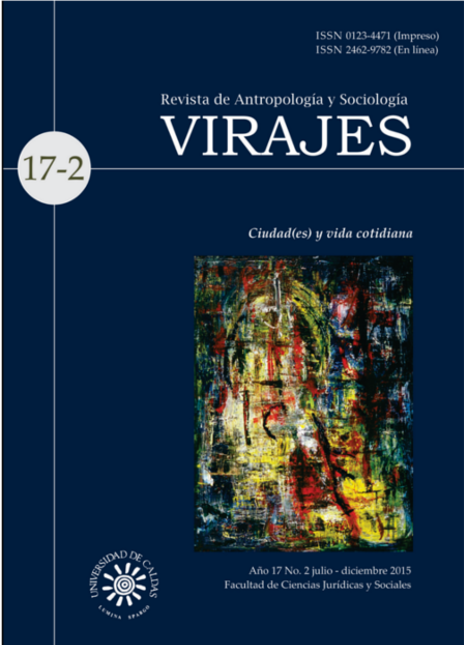Authors
Abstract
Objective. To build, from the archaeological characteristics of a domestic unit, social and political everyday life of a human group that inhabited the northwestern plains of Yucatan between 550/600 and 750/800 A. D. Methodology. To achieve this objective, information from the ceramic, lithic, architectural and osteological analysis was related. Results. Through the comprehensive analysis of a housing context in the peripheral site of Cholul, North of the city of Merida, discussions and outcomes on various topics relating to the domestic group who lived there, such as health and disease issues, the political and social structure of the group, gender relations and kinship, were considered. Conclusion. It is a fact that the human group that developed during the second half of the Classic period North of the present city of Merida reached a degree of material prosperity.
Keywords
References
Anderson, B. (1996). Reporte de los metates tipo “pila” de Chichén Itzá, Yucatán, registrados durante la temporada de campo de 1995. Texto mecanuscrito sin publicar.
Andrews, W. (1965). Archaeology and Prehistory in the Northern Maya Lowlands. En G. Willey, Handbook of Middle American Indians, Vol. 2. Austin, USA: University of Texas Press.
Arias, J.M. y Pool, M.N. (2003). Un caso de osteofitosis en un Grupo doméstico del Clásico Tardío Maya: ¿sedentarización o estrés físico?”. Arqueología, 30, 37-50.
Arias, J.M. y Pool, M.N. (2003). Análisis de la variabilidad biológica y social en el ámbito diacrónico en un grupo doméstico: Periférico-Cholul, Yucatán. Mexicon, 25 (2), 53-58.
Bardsley, S. (1996). Benches, brothers and lineage lords of Copán. En G. Robertson, M. Macri and J. McHarge (Ed.), Palenque Round Table. San Francisco, USA: Pre-Columbian Art Research Institute.
Carmack, R.M. (1981). The Quiché Maya of Utatlán: The Evolution of a Highland Guatemala Kingdom. Oklahoma, USA: University of Oklahoma Press.
Cash, C. (1998). Blood woman, blood queen: An exploration of gender, politics and the Maya. Austin, USA: University of Texas.
Civera, M. (1986). La adaptación biocultural como un problema interdisciplinario. Anales de Antropología, 23 (1), 331-348.
Eggan, F. (1934). The Maya kinship system and cross-cousin marriage. American Anthropologist, 36, 188-202.
Fry, R.E. (1969). Ceramics and settlement in the periphery of Tikal, Guatemala (Ph. D. dissertation). Department of anthropology, University of Arizona, Tucson, USA.
Haviland, W.A. (1981). Dower houses and minor centers at Tikal Guatemala: An Investigation into the identification of valid units in settlement hierarchies. En W. Ashmore (Ed.), Lowland Maya Settlement Patterns. Albuquerque, USA: University of New México Albuquerque.
Haviland, W.A. (1988). Musical hammocks at Tikal: Problems with reconstructing household composition. En W. Ashmore and R. Wilk (Ed.), Household and Community in the Mesoamerican Past. Albuquerque, USA: University of New México Press.
Hernández, A. y Pool, M.N. (2004). Género, parentesco y sucesión de estatus en un Grupo Doméstico del Período Clásico. Temas Antropológicos, 26 (1-2), 239-266.
Hendon, J. (2005). El papel de los enterramientos en la construcción y negociación de la identidad social en los mayas prehispánicos. En A.C. Ruiz, M.H. Ruz y M.J. Iglesias (Ed.), Antropología de la eternidad: la muerte en la cultura maya. Ciudad de México, México: Sociedad Española de Estudios Mayas, Universidad Nacional Autónoma de México.
Huchim, J. y Pool, M.N. (1995). Rescate arqueológico en el Periférico-Cholul. 56 Aniversario del INAH. Mérida, Yucatán, México.
Inomata, T. et al. (2002). Domestic and Political Lives of Classic Maya Elites: The Excavation of Rapidly Abandoned Structures at Aguateca, Guatemala. Latin American Antiquity, 3 (3), 305-330.
Inomata, T. and Stiver, L. (1994). Floor asemblages from elite households of Aguateca, Guatemala and their socioeconomic implications. 93rd Annual Meeting of the American Anthropological Association. Atlanta, USA.
Landa, D. (1997). Relación de las cosas de Yucatán. Mérida, México: Editorial Dante.
Morales, R.A. (2008). Excavación y restauración en Oxkintok, Yucatán. Estructura CA-4, CA- 26 y CA-27 (tesis de pregrado). Facultad de Ciencias Antropológicas de la Universidad Autónoma de Yucatán, Mérida, Yucatán, México.
Parsons, T. (1999). El sistema social. Madrid, España: Alianza editorial.
Pool, M.N. (1997). Crecimiento de una unidad doméstica (tesis de pregrado). Facultad de Ciencias Antropológicas de la Universidad Autónoma de Yucatán, Mérida, Yucatán, México.
Pool, M.N. (2003). Sistemas de descendencia y parentesco entre los mayas prehispánicos. Crítica al modelo de linaje (tesis de posgrado). Facultad de Ciencias Antropológicas de la Universidad Autónoma de Yucatán, Mérida, Yucatán, México.
Pool, M.N. (2011). Vida social y política de un grupo doméstico del período Clásico. En R. Cobos y L. Fernández (Coord.), Vida cotidiana de los antiguos mayas del norte de la península de Yucatán. Mérida, México: Ediciones de la Universidad Autónoma de Yucatán.
Pool, M.N. y Hernández, A. (2007). Las relaciones de género en un grupo doméstico de las planicies yucatecas. En M.J. Rodríguez (Coord.), Las mujeres en Mesoamérica Prehispánica. Toluca, México: Universidad Autónoma del Estado de México.
Pyburn, A. (2004). Ungendering the Maya. Ungendering Civilization. New York, USA: Routledge.
Ringle, W.M. and Andrews, W. (1988). Formative residences at Komchen, Yucatán, México. En W. Ashmore and R. Wilk (Ed.), Household and Community in the Mesoamerican Past. Albuquerque, USA: University of New México Press.
Sanahuja, Y. (2007). La cotidianidad en la Prehistoria. La vida y su sostenimiento. Barcelona, España: Icaria Antrazyt.
Schutz, A. y Luckman, T. (1977). Las estructuras del mundo de la vida. Buenos Aires, Argentina: Amorrortu editores.
Steinbock, R. (1976). Paleopathological diagnosis and interpretation. Springfield, USA: Thomas Publishers.
Varela, C. and Braswell, G.E. (2003). Teotihuacan and Oxkintok: New Perspectives from Yucatán. En G.E. Braswell (Ed.), The Maya and Teotihuacan. Reinterpreting Early Classic Interaction. Austin, USA: University of Texas Press.
Victoria, A.I. (2012). Vida cotidiana. Análisis comparativo entre grupos domésticos de las tierras bajas mayas durante el período clásico (tesis de pregrado). Facultad de Ciencias Antropológicas de la Universidad Autónoma de Yucatán, Mérida, Yucatán, México.
Wilk, R. and Rathje, W. (1982). Household Archaeology. American Behavioral Scientist, 25 (6), 617-639.

 PDF (Español)
PDF (Español)
 FLIP
FLIP














